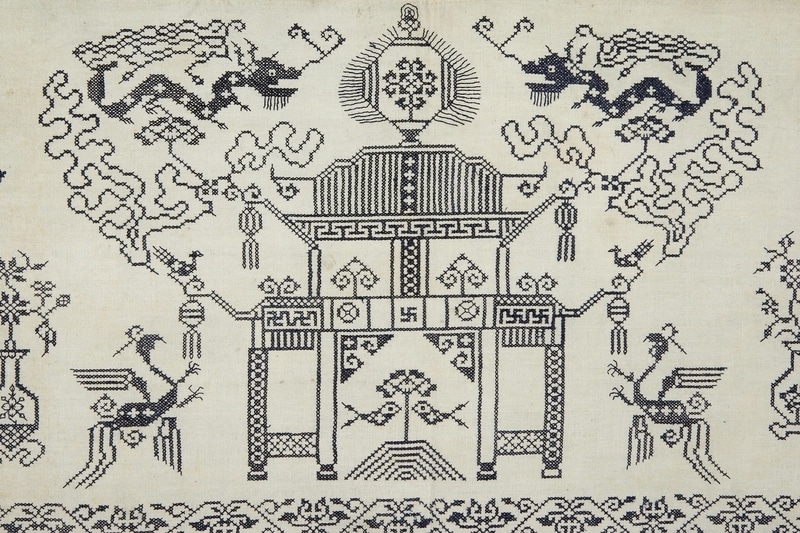Valance Item Number: Edz1252 from the MOA: University of British Columbia


Description
Embroidered white cotton valance has centre scene flanked by two identical medallions, surrounded by flowers, fruit, butterflies, vases, containers, mystic symbols. Centre scene contains dragon gate topped by plant in vase enclosed in rayed octagon which is capped by small symbol, all surrounded above by facing dragons, clouds and below by facing phoenixes . Gate holds crosses, swastikas, rosettes, tassels, birds, fishes, plants. Identical flanking medallions show a chi-lin, above it a human figure, cross on centre body, holding in one hand small human figure, in other, a flag; below, four mystic symbols, clouds surround. Edge: three-sided border, reversing flower, vine motifs. Long side, selvage; short sides, raw.
History Of Use
Blue and white embroideries are part of a long domestic tradition. Designs vary geographically but are constant within generations of families except for minor individual variations. Often used to decorate the bed which traditionally played a focal part in household ritual particularly at the new year when all household spirits were honored. They are family made, by women, and family owned. These embroideries were of no local commercial value.
Iconographic Meaning
Dragon gate, dragon, fish denote successful graduation or career, or many children; phoenix, peace and prosperity; clouds, beneficial rain and fertility; octagon and cross, cosmic symbols; swastika - Buddha's heart, supreme good luck symbol, used in special places. Chi-lin denotes birth, scholarship; four symbols with ribbon, Buddhist charms; lotus flowers, faithfulness; butterfly, joy and true love; peach, marriage, immortality, long life; Buddha's hand, wealth, divine protection; pear, longevity; coin with ribbon, wealth; vase, perpetual harmony; dish of flowers, beauty and harmony.
Cultural Context
utilitarian;household
Item History
- Made in Chengdu, Sichuan, China before 1945
- Collected between 1932 and 1945
- Owned by Kathleen F. Spooner before April 25, 1979
- Received from Kathleen F. Spooner (Seller) and Museum of Anthropology Donations Fund (Funding source) on April 25, 1979
What
- Name
- Valance
- Identification Number
- Edz1252
- Type of Item
- valance
- Material
- cotton fibre and indigo dye
- Manufacturing Technique
- woven, stitched, embroidered and dyed
- Overall
- height 34.5 cm, width 189.0 cm
Who
- Culture
- Chinese
- Previous Owner
- Kathleen F. Spooner
- Received from
- Kathleen F. Spooner (Seller) and Museum of Anthropology Donations Fund (Funding source)
Where
- Holding Institution
- MOA: University of British Columbia
- Made in
- Chengdu, Sichuan, China
When
- Creation Date
- before 1945
- Collection Date
- between 1932 and 1945
- Ownership Date
- before April 25, 1979
- Acquisition Date
- on April 25, 1979
Other
- Item Classes
- textiles
- Condition
- good
- Accession Number
- 0567/0027